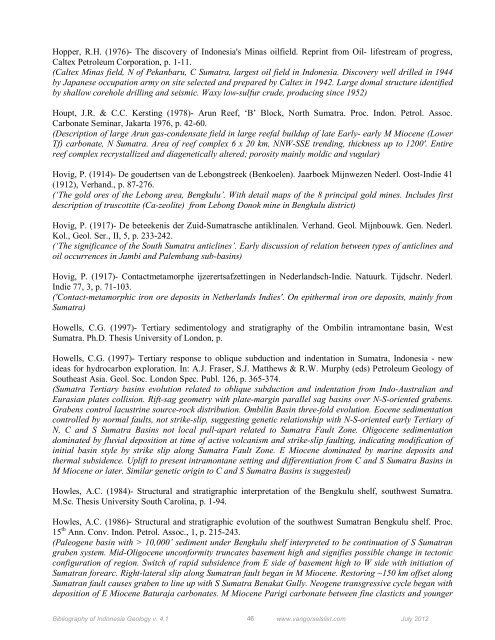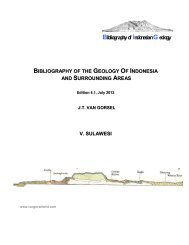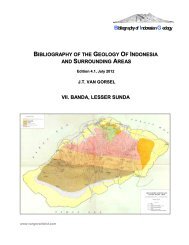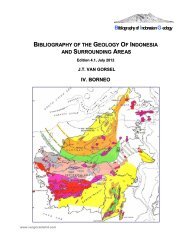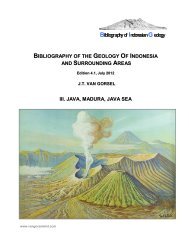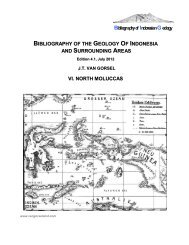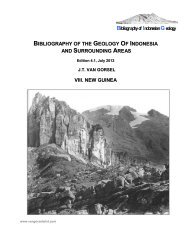Sumatra, Sunda Shelf, Natuna - Bibliography of Indonesia Geology
Sumatra, Sunda Shelf, Natuna - Bibliography of Indonesia Geology
Sumatra, Sunda Shelf, Natuna - Bibliography of Indonesia Geology
Create successful ePaper yourself
Turn your PDF publications into a flip-book with our unique Google optimized e-Paper software.
Hopper, R.H. (1976)- The discovery <strong>of</strong> <strong>Indonesia</strong>'s Minas oilfield. Reprint from Oil- lifestream <strong>of</strong> progress,<br />
Caltex Petroleum Corporation, p. 1-11.<br />
(Caltex Minas field, N <strong>of</strong> Pekanbaru, C <strong>Sumatra</strong>, largest oil field in <strong>Indonesia</strong>. Discovery well drilled in 1944<br />
by Japanese occupation army on site selected and prepared by Caltex in 1942. Large domal structure identified<br />
by shallow corehole drilling and seismic. Waxy low-sulfur crude, producing since 1952)<br />
Houpt, J.R. & C.C. Kersting (1978)- Arun Reef, B Block, North <strong>Sumatra</strong>. Proc. Indon. Petrol. Assoc.<br />
Carbonate Seminar, Jakarta 1976, p. 42-60.<br />
(Description <strong>of</strong> large Arun gas-condensate field in large reefal buildup <strong>of</strong> late Early- early M Miocene (Lower<br />
Tf) carbonate, N <strong>Sumatra</strong>. Area <strong>of</strong> reef complex 6 x 20 km, NNW-SSE trending, thickness up to 1200'. Entire<br />
reef complex recrystallized and diagenetically altered; porosity mainly moldic and vugular)<br />
Hovig, P. (1914)- De goudertsen van de Lebongstreek (Benkoelen). Jaarboek Mijnwezen Nederl. Oost-Indie 41<br />
(1912), Verhand., p. 87-276.<br />
(‘The gold ores <strong>of</strong> the Lebong area, Bengkulu’. With detail maps <strong>of</strong> the 8 principal gold mines. Includes first<br />
description <strong>of</strong> truscottite (Ca-zeolite) from Lebong Donok mine in Bengkulu district)<br />
Hovig, P. (1917)- De beteekenis der Zuid-<strong>Sumatra</strong>sche antiklinalen. Verhand. Geol. Mijnbouwk. Gen. Nederl.<br />
Kol., Geol. Ser., II, 5, p. 233-242.<br />
(‘The significance <strong>of</strong> the South <strong>Sumatra</strong> anticlines’. Early discussion <strong>of</strong> relation between types <strong>of</strong> anticlines and<br />
oil occurrences in Jambi and Palembang sub-basins)<br />
Hovig, P. (1917)- Contactmetamorphe ijzerertsafzettingen in Nederlandsch-Indie. Natuurk. Tijdschr. Nederl.<br />
Indie 77, 3, p. 71-103.<br />
('Contact-metamorphic iron ore deposits in Netherlands Indies'. On epithermal iron ore deposits, mainly from<br />
<strong>Sumatra</strong>)<br />
Howells, C.G. (1997)- Tertiary sedimentology and stratigraphy <strong>of</strong> the Ombilin intramontane basin, West<br />
<strong>Sumatra</strong>. Ph.D. Thesis University <strong>of</strong> London, p.<br />
Howells, C.G. (1997)- Tertiary response to oblique subduction and indentation in <strong>Sumatra</strong>, <strong>Indonesia</strong> - new<br />
ideas for hydrocarbon exploration. In: A.J. Fraser, S.J. Matthews & R.W. Murphy (eds) Petroleum <strong>Geology</strong> <strong>of</strong><br />
Southeast Asia. Geol. Soc. London Spec. Publ. 126, p. 365-374.<br />
(<strong>Sumatra</strong> Tertiary basins evolution related to oblique subduction and indentation from Indo-Australian and<br />
Eurasian plates collision. Rift-sag geometry with plate-margin parallel sag basins over N-S-oriented grabens.<br />
Grabens control lacustrine source-rock distribution. Ombilin Basin three-fold evolution. Eocene sedimentation<br />
controlled by normal faults, not strike-slip, suggesting genetic relationship with N-S-oriented early Tertiary <strong>of</strong><br />
N, C and S <strong>Sumatra</strong> Basins not local pull-apart related to <strong>Sumatra</strong> Fault Zone. Oligocene sedimentation<br />
dominated by fluvial deposition at time <strong>of</strong> active volcanism and strike-slip faulting, indicating modification <strong>of</strong><br />
initial basin style by strike slip along <strong>Sumatra</strong> Fault Zone. E Miocene dominated by marine deposits and<br />
thermal subsidence. Uplift to present intramontane setting and differentiation from C and S <strong>Sumatra</strong> Basins in<br />
M Miocene or later. Similar genetic origin to C and S <strong>Sumatra</strong> Basins is suggested)<br />
Howles, A.C. (1984)- Structural and stratigraphic interpretation <strong>of</strong> the Bengkulu shelf, southwest <strong>Sumatra</strong>.<br />
M.Sc. Thesis University South Carolina, p. 1-94.<br />
Howles, A.C. (1986)- Structural and stratigraphic evolution <strong>of</strong> the southwest <strong>Sumatra</strong>n Bengkulu shelf. Proc.<br />
15 th Ann. Conv. Indon. Petrol. Assoc., 1, p. 215-243.<br />
(Paleogene basin with > 10,000’ sediment under Bengkulu shelf interpreted to be continuation <strong>of</strong> S <strong>Sumatra</strong>n<br />
graben system. Mid-Oligocene unconformity truncates basement high and signifies possible change in tectonic<br />
configuration <strong>of</strong> region. Switch <strong>of</strong> rapid subsidence from E side <strong>of</strong> basement high to W side with initiation <strong>of</strong><br />
<strong>Sumatra</strong>n forearc. Right-lateral slip along <strong>Sumatra</strong>n fault began in M Miocene. Restoring ~150 km <strong>of</strong>fset along<br />
<strong>Sumatra</strong>n fault causes graben to line up with S <strong>Sumatra</strong> Benakat Gully. Neogene transgressive cycle began with<br />
deposition <strong>of</strong> E Miocene Baturaja carbonates. M Miocene Parigi carbonate between fine clasticts and younger<br />
<strong>Bibliography</strong> <strong>of</strong> <strong>Indonesia</strong> <strong>Geology</strong> v. 4.1 46 www.vangorselslist.com July 2012


